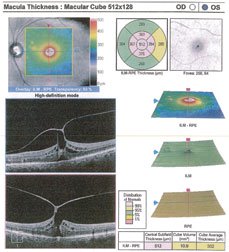Use of OCT becomes more common prior to cataract surgery
At Issue asked: “Under what circumstances would you perform ocular coherence tomography in contemplation of cataract surgery?”
With suspected macular disease
John A. Hovanesian, MD, FACS: Ocular coherence tomography has revolutionized the way we examine the macula, affording us a view of anatomic detail that was never before possible. Its use in evaluating epiretinal membranes, macular edema, macular degeneration and other disorders is unmistakable. In my practice, there are two roles for the use of OCT prior to cataract surgery.
First, for patients with suspected macular disease, OCT scanning can define the extent and configuration of the anatomic defect. This, combined with potential acuity testing, can help us define the visual potential in an eye with comorbidities of macular disease and cataract. In this setting of existing disease, the OCT test is billed to the patient’s insurance company or Medicare with the appropriate diagnostic code.
Second, OCT can be used as a screening tool in patients not expected to have macular disease. This is most useful for patients electing a premium lens implant, where the view of the macula can be compromised by cataract and where we want to know in advance about a subtle epiretinal membrane or other pathology that might be missed on exam.

John A. Hovanesian
In these patients, the unexpected presence of macular disease would be an unpleasant surprise after premium surgery. In my practice, part of the “premium package” for which patients pay with refractive cataract surgery is a preoperative OCT. It is important to remember that an OCT scan cannot be billed to insurance or Medicare solely as a screening test for macular disease. The test is only billable when an exam first confirms the presence of disease and the OCT is intended strictly to further define its anatomic extent.
When cataract does not account for acuity loss

Brett G. Bence
Brett G. Bence, OD, FAAO: Macular program OCT is an excellent auxiliary tool when the severity of cataract does not appear to fully account for the loss of visual acuity. As we know, many occult and subtle macular factors may influence best corrected visual acuity, including pigment epithelial detachment, subretinal pathology, interface disorders, intraretinal edema and others. If the patient has diabetes, we are particularly interested in a presurgical OCT to establish presence of pre-existing macular edema.

This macular OCT, performed in a patient prior to cataract surgery, uncovered an astonishing presentation of vitreomacular traction.
Image: Bence BG
We utilize a Cirrus HD-OCT (Carl Zeiss Meditec, Dublin, Calif.). Whether you use this or similar technology from other companies, we recognize that these retinal scans offer amazing cross-sectional macular views, sometimes with unanticipated results. Viewing these images with the patient during the cataract consultation can be a tremendously worthwhile exercise. Pointedly, this helps objectively quantify the status of macular integrity as an important element of cataract consultation and an indicator of postsurgical visual prognosis. That being said, anyone who routinely works with OCT can perhaps agree that, in some instances, there can be a disconnect between objective anatomical image and subjective visual acuity involving physiologic function.
On occasion, we obtain OCT macular images for patients who will be obtaining premium intraocular lenses. These patients often have higher expectations for postsurgical recovery, and an OCT macular scan could help assure no pre-existing macular pathology undetectable by ophthalmoscopy, particularly if the cataract relatively obscures the examiner’s view.
When cataract density, subjective complaints do not correlate

Louis D. “Skip” Nichamin
Louis D. “Skip” Nichamin, MD: The use of OCT in the context of modern implant surgery has essentially become “indispensable” for the progressive cataract surgeon. In fact, it is difficult to imagine practicing without this technology. This is particularly true in light of the unprecedented levels of success expected by today’s cataract patients and especially those who are increasingly undergoing lens-based refractive procedures.
OCT found its way into our armamentarium originally when treating cataract patients who harbored or were suspected to have concomitant retinal disease — this being especially true for age-related macular degeneration and diabetic retinopathy, diseases frequently associated with cataract. Scanning of the macula preoperatively yielded important prognostic information and would often help guide treatment decisions. This tool was also crucial in managing patients through their postoperative courses. Today, its role has vastly expanded both in regard to patients with known retinal pathology and many without established posterior segment disease.
It is now widely accepted that Snellen acuity is but one parameter used to determine the need for cataract intervention, and surgery is increasingly based upon symptoms and interference with activities of daily living. In cases where the cataract density and subjective complaints do not appear to correlate, OCT testing preoperatively can be extremely useful. Similarly, when postoperative results are not at an expected level, clinical examination and scanning of the macula is indicated.
With improvements in intraocular lens designs and refined refractive outcomes, implant surgery has evolved into a legitimate refractive option, especially for correction of high degrees of ametropia (wherein keratorefractive surgery may not be appropriate) as well as for presbyopia. OCT testing preoperatively in this demanding patient population is important to rule out subtle preexisting macular pathology and can detect postoperative issues such as cystoid macular edema that may be contributing to less-than-optimal results.
